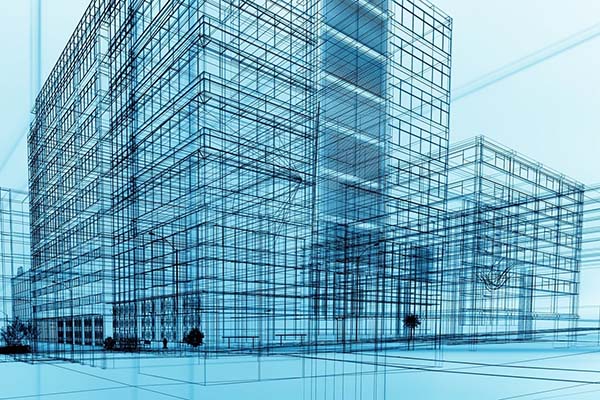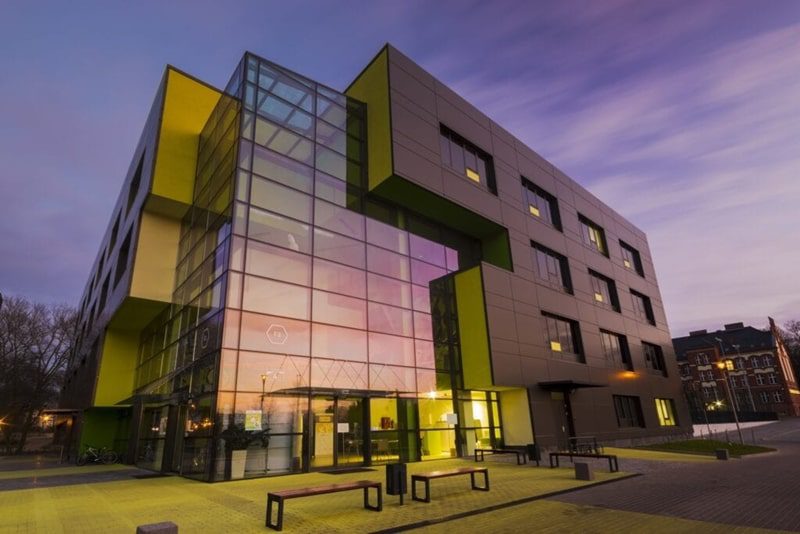There are many reasons to consider the sustainability of a new or existing building. We use huge amounts of energy to heat, cool, light, and ventilate the spaces we all work in, and trying to use less energy in these processes is a great way to save money on building operations and reduce our impact on the environment. One of the most recognizable but often misunderstood ways of defining a green building is the LEED certification. If you are curious about the benefits and requirements of a building becoming LEED-certified, this is a great place to start.
What is LEED? (where, why)
The Leadership in Energy and Environmental Design™ (LEED®) certification is a third-party green building system developed and certified by the US Green Building Council (USGBC). LEED is the most widely used certification program in the world with more than 94,000 projects in over 165 countries and territories. Every day an average 2.4 million square feet of building space becomes LEED-certified. Becoming LEED-certified is an instantly recognizable way of showing your clients, customers, partners, and community that you are committed to decarbonizing your building through increased energy efficiency and sustainability practices. LEED certification has several rating levels and requires USGBC verification of sustainability measures before certification is bestowed.
Who is in charge of LEED?
The certifying body for LEED certification is the USGBC, a private 501(c)3 membership-based non-profit that was established in 1993. The purpose of the USGBC is to promote sustainability in building design, construction, and operation, which is most prominently enacted through the LEED program. In addition to providing institutional backing and management of the LEED certification, the USGBC is responsible for the annual Greenbuild International Conference and was among several national green building organizations that helped found the World Green Building Council.
The USGBC manages the LEED program through its partnership with Green Building Certification Incorporated (GBCI) by providing independent program oversight, including offering a suite of professional credentials needed to verify LEED projects.
What are the different LEED rating systems?
There are four rating levels of LEED certification ranging from LEED® Certified™, the most basic, up to LEED Platinum®, the highest green building certification offered through the LEED program. The certificate level awarded is based on a 110 point scale requiring a minimum of 40 for basic LEED certification, and a score of 80 for LEED Platinum®. The score is based on six categories with a total of 100 points, and an additional 10 points available for a total of 110 points.
| Score Category | LEED v4 BD+ C Available Points | LEED v4 O&M Available Points |
|
Location and Transportation |
16 points available | 15 points available |
| Sustainable Sites | 10 points available | 10 points available |
| Water Efficiency | 11 points available | 12 points available |
| Energy and Atmosphere | 33 points available | 38 points available |
| Materials and Resources | 13 points available | 8 points available |
| Indoor Environmental Quality | 16 points available | 17 points available |
| Additional points: Regional Priority Credits and Innovation in Design | 4 points for regional priority
6 for innovation in design – available for above and beyond design in one of the 6 main categories |
4 points for regional priority
6 for innovation in design – available for above and beyond design in one of the 6 main categories |
The points system, introduced in 2009, is designed to allocate points based on the potential environmental impacts and human benefits of each credit, which are then weighted using reference buildings and project data to assign points in each category. In each score category, there are prerequisites that must be attained and numerous credits that can be attained to achieve the desired score. The environmental impact and data standards are based on standards set by the US Environmental Protection Agency and the National Institute of Standards and Technology.
In addition to the rating levels of LEED® Certified™, LEED Silver®, LEED Gold®, LEED Platinum®, there is a LEED certification for each type of building project, each of which is applicable to a particular class of projects. Learn about each type from the chart below and visit the USGBC LEED website to learn more about the specifics of each project type.
LEED Certification Project Types |
|
|
Building Design + Construction (BD+C) |
For new construction or major renovations; includes New Construction, Core & Shell, Schools, Retail, Hospitality, Data Centers, Warehouses & Distribution Centers, and Healthcare. |
| Interior Design + Construction (ID+C) | For complete interior fit-out projects; includes Commercial Interiors, Retail and Hospitality. |
| Building Operations + Maintenance (O+M) | For existing buildings that are undergoing improvement work or little to no construction; includes Existing Buildings, Schools, Retail, Hospitality, Data Centers and Warehouses & Distribution Centers. |
| Neighborhood Development (ND) | For new land development projects or redevelopment projects containing residential uses, nonresidential uses, or a mix. Projects can be at any stage of the development process, from conceptual planning to construction; includes Plan and Built Project. |
| Homes | For single-family homes, low-rise multi-family (one to three stories) or mid-rise multi-family (four to six stories); includes Homes and Multifamily Lowrise and Multifamily Midrise. |
| Cities and Communities | For entire cities and sub-sections of a city. Using the Arc performance platform, LEED for Cities projects can measure and manage their city’s water consumption, energy use, waste, transportation and human experience. |
| LEED Recertification | Applies to all occupied and in-use projects that have previously achieved certification under LEED – including BD+C and ID+C, regardless of their initial rating system or version. |
| LEED Zero |
Available for all LEED projects certified under the BD+C or O+M rating systems, or registered to pursue LEED O+M certification. LEED Zero is for projects with net zero goals in carbon and/or resources. |
LEED Credentials
Now that you have a general idea of the basic concept of LEED certification and the organization responsible for administrating LEED at the program level, you may be wondering how you can integrate LEED into your new project or existing building. The first step in becoming LEED Certified is contracting with an appropriately credentialed LEED building professional.
There are several types of LEED credentials available. The most basic LEED credential is the LEED Green Associate, which requires a general knowledge of green building practices and allows certified Green Associates to support others working on LEED projects. Beyond the LEED Green Associate accreditation, there is LEED AP (Accredited Professional) as well as a host of specialty accreditations including Building Design and Construction (LEED AP BD+C), Operations and Maintenance (LEED AP OP+M), Interior Design and Construction (LEED AP ID+C), Neighborhood Development (LEED AP ND), and LEED AP Homes.
Choosing which accredited personnel your project needs depends on the scale and type of project you are doing. Once you have gotten in contact with a LEED-certified professional, they should be able to guide your project towards certification. The Veregy team of professionals hold certifications in LEED AP, LEED AP IC+D, LEED O+M, and LEED AP BD+C.
How does LEED work?
Having a designer or project manager accredited by the USGBC to work on LEED projects is a huge first step towards a LEED-certified project, but you probably still have many questions regarding the LEED process. The first thing to understand is that even though the USGBC is responsible for managing and promoting LEED, the actual certification is issued by Green Building Certification Incorporated (GBCI).
For new construction certification, a building’s team is responsible for two separate applications in the process: one application detailing design credits which relate to the proposed operation of the building once it is finished, and one application detailing construction credits which relates to the processes, materials, and commissioning of the building. The design credits usually relate to the work done by architects and engineers in planning the building, while the construction credits are handled by the contractors and are documented during the construction phase. These two applications are handled consecutively.
There are fees required for registering and submitting applications to receive LEED certification from the GBCI. These fees are based on building square footage and usually end up costing an additional 2% of the total building cost.
The designated LEED-certified professional on the building team is responsible for submitting the LEED applications, and with their training should have a good idea of which type of certification your building will qualify for. Many parties begin a project with the end goal of receiving a LEED Silver or Gold certification, and having a target to aim at in advance of the start of the building design and construction is the best way to ensure you will receive the certification you are after. It is advisable to plan on achieving more credits than is actually required, as a buffer in case some credits are not realized.
How can I achieve LEED on my building?
The first step toward LEED certification on a new building is employing a LEED professional on your design team and submitting your building’s design application early on in the process. It is a good idea to have one member of the design team as the designated LEED point of contact, whose responsibility it is to submit applications and keep the project on track for the desired LEED certification.
Deciding which level of LEED certification to strive for is another important consideration. Note the fact that LEED Platinum® requires twice the minimum score for basic LEED certification. This does not necessarily mean that Platinum is twice as costly or difficult to attain. Importantly, both new and existing buildings are eligible to be certified as green buildings, and retrofitting an existing building is typically the most environmentally friendly route.
There is a vast pool of knowledge regarding LEED, green building certifications, and the best methods and designs for attaining them. Which design strategies and certifications are right for your project can be a complicated question to answer. Fortunately, there are thousands of USGBC credentialed engineers, architects, contractors, planners, sustainability professionals, and builders in the US who have the expertise to guide you through the process. Veregy has been involved in LEED certification projects for over 20 years. With a team of professionals certified as LEED AP, LEED AP IC+D, LEED O+M, and LEED AP BD+C, we are ready to help.
To start on your path to LEED success today, contact the Veregy team today.


